Getting Started at Boulder Exe…
Bouldering is booming! More people than ever are stepping onto the mats for the first time—so what’s the best way to start? We sat down with Ollie (Duty Manager and Performance Coach), Joe (Head Setter) and Ben (Route Setting Manager) to answer some of the most common questions about bouldering and how to get the most out of your sessions.
What is bouldering?
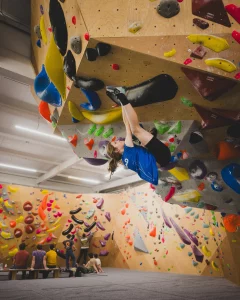 Ollie: Bouldering is a type of climbing where you climb short routes – called problems’—without ropes or harnesses. Instead of going high up, boulder problems’ are low level climbs where you’re protected by thick crash mats. Every problem is a movement puzzle, solved through balance, technique, and grip.
Ollie: Bouldering is a type of climbing where you climb short routes – called problems’—without ropes or harnesses. Instead of going high up, boulder problems’ are low level climbs where you’re protected by thick crash mats. Every problem is a movement puzzle, solved through balance, technique, and grip.
It’s a full-body workout, but it’s also creative and social. You can try different ways of solving problems, chat with other climbers, and push yourself at your own pace.
How has bouldering evolved?
Ollie: Originally a training tool for roped climbers, bouldering evolved into a standalone sport, that is now featured in the Olympics and spreading worldwide. What started as short, powerful climbs on natural rock is now an accessible indoor sport for everyone, from beginners to elite athletes.
Indoor walls allow for precise route-setting (what we call the process of making the climbs), dynamic movement, and community-driven climbing. It’s not just about strength—it’s about problem-solving, technique, and having fun with others. Bouldering is super accessible. You don’t need loads of gear—just a pair of climbing shoes and some chalk. The social side is also huge. In roped climbing, you typically need a partner, but in bouldering, you can turn up on your own to climb or instantly be part of a group on the wall, chatting about routes and sharing tips.
Bouldering seems to be growing fast—who does it appeal to today?
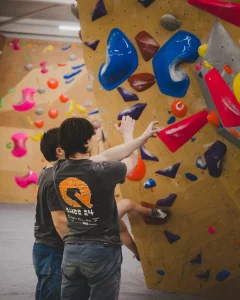 Ollie: Climbing has steadily grown in popularity for nearly 40 years, but the 2020s have seen an unprecedented boom in the popularity of bouldering, making it the fastest-growing element of the sport. More people than ever are stepping onto the mats for the first time. Bouldering appeals to a wide range of people—those looking for a fun and social way to stay active, athletes from other sports seeking a new challenge, and anyone who loves problem-solving and movement.
Ollie: Climbing has steadily grown in popularity for nearly 40 years, but the 2020s have seen an unprecedented boom in the popularity of bouldering, making it the fastest-growing element of the sport. More people than ever are stepping onto the mats for the first time. Bouldering appeals to a wide range of people—those looking for a fun and social way to stay active, athletes from other sports seeking a new challenge, and anyone who loves problem-solving and movement.
What’s the best way to start?
Ollie: If you’re new, our Boulder Basics session is the best place to begin. It’s a relaxed, instructor-led introduction covering how to use the bouldering walls, fall safely, and some useful climbing techniques. You’ll also get a feel for different climbing styles and start learning how to read boulder problems. It can be intimidating walking into a climbing gym for the first time – Boulder Basics is designed to eliminate this issue and ensure you feel confident getting started.
Boulder Basics is free—just book a time slot and pay the normal entry fee. We’ll sort your hire shoes and chalk, so all you need to do is show up and climb!
How do I know which climbs to try?
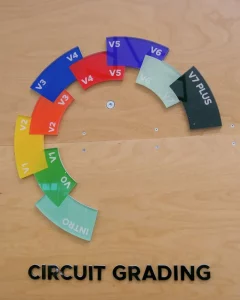
Joe: At Boulder Exe, we use the V Grade system—which is super easy to understand and widely recognised. Each problem is set with a different level of difficulty, which we call a ‘grade’. Grades help you track progress and find climbs that suit your ability. The higher the number, the harder the climb. If you’re new, start with lower V grades, focusing on technique rather than just strength.
Each climb is colour coded – our Circuit Signs show you the colour for the grade you wish to climb. Climbs have a coloured start tag and finishing logo – this makes it super easy for you identify the level of each climb. The Mint VB tags are the easiest and the blacks are the hardest (V7 and above range).
Why Did You Choose to Follow the V Grade System?
Joe: We chose the V Grade system for two key reasons: it’s simple to understand and it aligns with our ethos of making climbing accessible and transferable beyond our walls.
At Boulder Exe, we’re all about helping people become climbers for life. That means equipping you with the skills to progress, whether you’re here for fun, training seriously, or planning to take your climbing outdoors. A big part of that is making sure our grading is consistent, credible, and useful wherever you climb—not just at Boulder Exe.
The V Grade system is globally recognised, used both indoors and outdoors. This makes it highly transferable—if you climb V4 at Boulder Exe, you’ll have the technical and physical ability to climb V4 anywhere. Many indoor grading systems differ from outdoor climbing, making the transition from gym to rock difficult. V Grades eliminate that gap—they originated outdoors, so using them helps prepare you for real rock. If you can climb V4 indoors at Boulder Exe, you should be able to tackle a V4 on Dartmoor, in Fontainebleau, or anywhere else around the world.
By using this system, we ensure that your climbing journey doesn’t stop at our doors but can transition anywhere.
The Grading and Holds Look Different from Other Walls – Why?
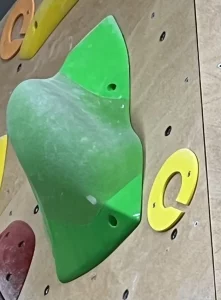 Joe: Not all climbing walls use the V Grade system, and grading approaches vary – it’s always worth checking how each wall you visit categorises their climbs. Some walls have their own systems, while others use hold colours to indicate difficulty—one colour per grade. At Boulder Exe, we do things differently: the tags denote the grade, not the holds. That means you’ll see the same colour holds across multiple grades rather than having them locked into specific difficulty levels.
Joe: Not all climbing walls use the V Grade system, and grading approaches vary – it’s always worth checking how each wall you visit categorises their climbs. Some walls have their own systems, while others use hold colours to indicate difficulty—one colour per grade. At Boulder Exe, we do things differently: the tags denote the grade, not the holds. That means you’ll see the same colour holds across multiple grades rather than having them locked into specific difficulty levels.
Ben: This is a deliberate choice that reflects our ethos. We want every climber—whether you’re new or highly experienced—to engage with the same range of holds, movement styles, and technical challenges. Some climbing walls set beginner climbs with simpler holds, focusing more on raw strength than movement. We take a different approach: every grade at Boulder Exe includes the same variety of holds and movement styles—we just fine-tune the difficulty level and angles. This ensures that every climb includes the same variety of technical shapes, movement challenges, and physical demands, regardless of grade—we simply fine-tune the difficulty and angles to match. This supports the learning process and encourages you to solve problems “like a climber” at every level, developing skills that will carry you through every grade.
How are problems set at Boulder Exe?
Joe: Setting is all about creating movement. We don’t just think about difficulty—we design problems to be fun, interesting, and varied.
Route setting and grading blend art and science—we aim to be objective, setting each boulder with a grade in mind. But grading isn’t just a number; we test every climb and assess it against key factors: physical intensity, complexity, crux moves, and technical demands. Setters always balance risk, intensity, and complexity, while also considering variables like height, flexibility, and overall physicality. What we don’t do is grade down—our grading may feel tough, but it’s intentional. We stay true to the V-grade system to keep our benchmarks credible.
Talk to me about the holds and volumes you use on the wall.
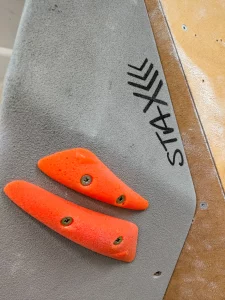 Ben: Nearly all our holds are brand new, featuring some of the best designs on the market—many of the same holds used in IFSC World Cup competitions. We’ve got a mix of shapes, textures, and styles to create a diverse and engaging climbing experience.
Ben: Nearly all our holds are brand new, featuring some of the best designs on the market—many of the same holds used in IFSC World Cup competitions. We’ve got a mix of shapes, textures, and styles to create a diverse and engaging climbing experience.
Holds are tools that shape movement and make for more interesting problems. Every hold has a functional purpose—different textures, surfaces, grips, and shapes are all designed to help you move better and in more creative ways. Holds are also incredibly versatile: a hold might be part of a complex, high-end problem one day and then repurposed into a beginner-friendly climb the next. That’s the goal—to ensure all our climbers experience a wide range of holds, rather than limiting certain types to specific grades.
Volumes take this even further. Our wall angles are already varied and dynamic, but adding large volumes lets us keep experimenting with angles and movement, making every climb feel fresh.
How often do you reset climbs?
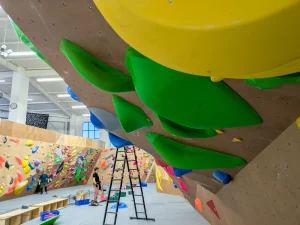
Ben: We’re all about providing ongoing challenge—keeping the centre fresh and keeping you on your toes with a steady turnover of routes, so there’s always a new and interesting project (the name for a climb you’re working to complete). That’s why we’ve set ourselves the goal of resetting the entire centre every six weeks.
Each week, we reset one or two zones (sections of the wall)—a high turnover that’s relatively niche in the industry. To stay in the loop, check out our fortnightly social media posts and info boards in the centre for the latest on what’s being set each day!
What if I get stuck on a problem?
Joe: Getting stuck is part of the process! Climbing is about problem-solving, not just strength. If you’re struggling, take a step back and reassess—are you using your feet well? Are you distributing your weight efficiently? Think outside of the box – if you’re attempting a climb within your usual grade range, it’s rarely a physical barrier that’s stopping you.
Most importantly, don’t be afraid to ask for advice about a route (or ‘beta’ as climbers call it) —our team and fellow climbers are always happy to share knowledge and help others achieve success. That’s what ‘climbing for everyone’ looks like!
Final Thoughts – Why should people try bouldering?
Ollie: It’s fun, social, and rewarding. Whether you’re looking for a new way to stay active, push your limits, or just meet great people, bouldering has something for everyone.
Just turn up and give it a go! Climbing is all about trying, falling, learning, and progressing. The community is welcoming, and every climb is a chance to level up. The point isn’t to get to the top of the problem every time – that would be too easy! It’s to learn, progress and feel that sense of satisfaction that comes with unlocking the physical and mental puzzle of the route.
And don’t be afraid to chat with other climbers—everyone remembers what it’s like to be new, and the community is super supportive.
Follow this link to book your Boulder Basics session.



